Podcast
Questions and Answers
What primarily drives the process of diffusion?
What primarily drives the process of diffusion?
- Temperature of the solution
- Chemical reactions
- Concentration gradients
- Kinetic energy of particles (correct)
Which factor does NOT affect the rate of diffusion?
Which factor does NOT affect the rate of diffusion?
- Presence of membrane transport proteins (correct)
- Temperature
- Steepness of the concentration gradient
- Surface area of the membrane
How does an increase in temperature affect the rate of diffusion?
How does an increase in temperature affect the rate of diffusion?
- It reverses the diffusion process
- It slows down the rate of diffusion
- It increases the rate of diffusion (correct)
- It has no effect
What is true about simple diffusion?
What is true about simple diffusion?
Which example is NOT typically transported via simple diffusion?
Which example is NOT typically transported via simple diffusion?
In which circumstance would diffusion generally take the longest?
In which circumstance would diffusion generally take the longest?
What role do integral membrane proteins play in facilitated diffusion?
What role do integral membrane proteins play in facilitated diffusion?
Which of the following statements about molecules moving through facilitated diffusion is true?
Which of the following statements about molecules moving through facilitated diffusion is true?
What happens to undigested material in a phagosome?
What happens to undigested material in a phagosome?
What is the main function of pinocytosis?
What is the main function of pinocytosis?
During exocytosis, what forms inside the cell to release materials?
During exocytosis, what forms inside the cell to release materials?
Which type of cells liberate digestive enzymes and hormones through exocytosis?
Which type of cells liberate digestive enzymes and hormones through exocytosis?
What occurs to the smaller molecules after pinocytosis?
What occurs to the smaller molecules after pinocytosis?
What is transcytosis?
What is transcytosis?
Which statement about exocytosis is true?
Which statement about exocytosis is true?
What is one possible outcome of substances released during exocytosis?
What is one possible outcome of substances released during exocytosis?
What type of diffusion allows solutes that are too polar to move through the lipid bilayer?
What type of diffusion allows solutes that are too polar to move through the lipid bilayer?
What are most membrane channels typically selective for?
What are most membrane channels typically selective for?
How do ions typically cross the plasma membrane through ion channels?
How do ions typically cross the plasma membrane through ion channels?
What role does a 'gated' channel play in facilitated diffusion?
What role does a 'gated' channel play in facilitated diffusion?
In carrier-mediated facilitated diffusion, what triggers the release of the solute?
In carrier-mediated facilitated diffusion, what triggers the release of the solute?
What effect does an isotonic solution have on red blood cells?
What effect does an isotonic solution have on red blood cells?
What is a characteristic of ion channels compared to free diffusion through the lipid bilayer?
What is a characteristic of ion channels compared to free diffusion through the lipid bilayer?
Which solution is an example of a hypotonic solution?
Which solution is an example of a hypotonic solution?
How does a carrier in carrier-mediated facilitated diffusion interact with the solute?
How does a carrier in carrier-mediated facilitated diffusion interact with the solute?
What happens to red blood cells in a hypertonic solution?
What happens to red blood cells in a hypertonic solution?
Which of the following best describes facilitated diffusion overall?
Which of the following best describes facilitated diffusion overall?
What is the primary process involved in dialysis?
What is the primary process involved in dialysis?
Which of the following describes hemolysis?
Which of the following describes hemolysis?
What defines an isotonic solution in relation to RBCs?
What defines an isotonic solution in relation to RBCs?
What occurs during crenation of red blood cells?
What occurs during crenation of red blood cells?
What is a characteristic of a semipermeable membrane in the context of osmosis?
What is a characteristic of a semipermeable membrane in the context of osmosis?
What determines the rate of carrier-mediated facilitated diffusion?
What determines the rate of carrier-mediated facilitated diffusion?
What happens when all carrier proteins in the plasma membrane are occupied?
What happens when all carrier proteins in the plasma membrane are occupied?
Which process requires energy to move solutes against a concentration gradient?
Which process requires energy to move solutes against a concentration gradient?
What is the primary source of energy for primary active transport?
What is the primary source of energy for primary active transport?
Which pump is considered the most prevalent primary active transport mechanism?
Which pump is considered the most prevalent primary active transport mechanism?
How does the Sodium-Potassium pump primarily function?
How does the Sodium-Potassium pump primarily function?
What is the role of carrier proteins in facilitated diffusion?
What is the role of carrier proteins in facilitated diffusion?
Which substances typically utilize carrier-mediated facilitated diffusion?
Which substances typically utilize carrier-mediated facilitated diffusion?
Flashcards are hidden until you start studying
Study Notes
Membrane Physiology: Factors Affecting Diffusion
- Diffusion is a passive process involving the random mixing of particles due to their kinetic energy, occurring in both solutes and solvents.
- Solutes move from areas of high concentration to low concentration, following their concentration gradient.
Factors Influencing Diffusion Rate
- Concentration Gradient: A steeper gradient increases diffusion rate.
- Temperature: Higher temperatures enhance diffusion speed, notably in feverish conditions.
- Surface Area: Larger surface areas facilitate faster diffusion.
- Diffusion Distance: Longer distances slow down the diffusion process.
Types of Diffusion
-
Simple Diffusion:
- Occurs freely through the lipid bilayer without membrane proteins.
- Non-polar molecules (e.g., O2, CO2, fatty acids, fat-soluble vitamins) and small uncharged polar molecules (e.g., water, urea) can freely diffuse.
-
Facilitated Diffusion:
-
Involves integral membrane proteins aiding specific substances across the membrane.
-
Channel-Mediated:
- Solutes travel down their concentration gradient through ion channels.
- Channels are selective for ions like potassium and chloride; transport is slower than through the lipid bilayer.
- Gated channels open/close based on cellular changes.
-
Carrier-Mediated:
- Carriers bind solutes on one side and release them on the other after shape changes.
- The rate depends on concentration gradient steepness and carrier availability, with saturation occurring when all carriers are occupied.
- Common substances include glucose and some vitamins.
-
Active Transport
- An energy-requiring process where carriers move solutes against their concentration gradient using ATP or ionic gradients.
- Primary Active Transport:
- Directly uses ATP to change carrier protein shape, such as the Sodium-Potassium Pump, which maintains low intracellular sodium and high potassium concentrations.
Endocytosis and Exocytosis
-
Endocytosis: Engulfing substances into the cell via vesicles.
- Phagocytosis: Engulfment of large particles.
- Pinocytosis: Engulfment of extracellular fluid.
-
Exocytosis: Materials are expelled from the cell, involving secretory vesicles fusing with the plasma membrane.
-
Transcytosis: Involves endocytosis on one side of the cell, transport across, and exocytosis on the opposite side.
Tonicity
- Describes a solution's effect on cell volume via water content alterations.
- Isotonic Solution: Equal solute concentrations, maintaining cell shape (e.g., 0.9% NaCl).
- Hypotonic Solution: Lower solute concentration than cells, causing cells to swell and possibly burst (hemolysis).
- Hypertonic Solution: Higher solute concentration than cells, leading to cell shrinkage (crenation).
Dialysis
- Process involving a semipermeable membrane that separates particles by size, allowing small molecules to diffuse while retaining larger molecules.
Studying That Suits You
Use AI to generate personalized quizzes and flashcards to suit your learning preferences.




